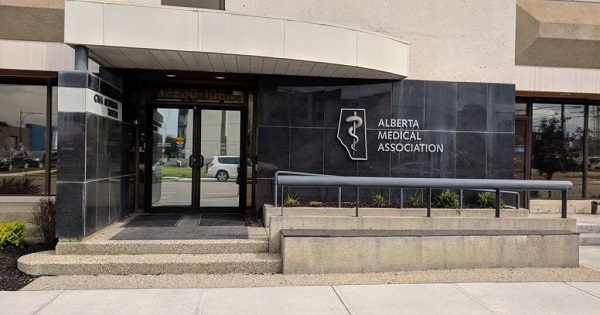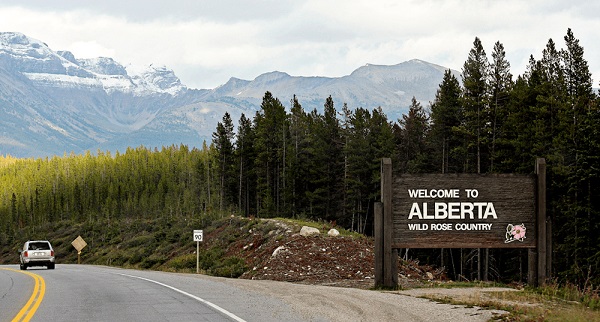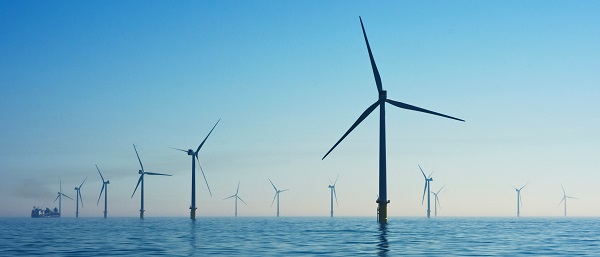Alberta
AMA challenged to debate Alberta COVID-19 Review

Justice Centre President sends an open letter to Dr. Shelley Duggan, President of the Alberta Medical Association
Dear Dr. Duggan,
I write in response to the AMA’s Statement regarding the Final Report of the Alberta Covid Pandemic Data Review Task Force. Although you did not sign your name to the AMA Statement, I assume that you approved of it, and that you agree with its contents.
I hereby request your response to my questions about your AMA Statement.
You assert that this Final Report “advances misinformation.” Can you provide me with one or two examples of this “misinformation”?
Why, specifically, do you see this Final Report as “anti–science and anti–evidence”? Can you provide an example or two?
Considering that you denounced the entire 269-page report as “anti–science and anti–evidence,” it should be very easy for you to choose from among dozens and dozens of examples.
You assert that the Final Report “speaks against the broadest, and most diligent, international scientific collaboration and consensus in history.”
As a medical doctor, you are no doubt aware of the “consensus” whereby medical authorities in Canada and around the world approved the use of thalidomide for pregnant women in the 1950s and 1960s, resulting in miscarriages and deformed babies. No doubt you are aware that for many centuries the “consensus” amongst scientists was that physicians need not wash their hands before delivering babies, resulting in high death rates among women after giving birth. This “international scientific consensus” was disrupted in the 1850s by a true scientist, Dr. Ignaz Semmelweis, who advocated for hand-washing.
As a medical doctor, you should know that science is not consensus, and that consensus is not science.
It is unfortunate that your AMA Statement appeals to consensus rather than to science. In fact, your AMA Statement is devoid of science, and appeals to nothing other than consensus. A scientific Statement from the AMA would challenge specific assertions in the Final Report, point to inadequate evidence, debunk flawed methodologies, and expose incorrect conclusions. Your Statement does none of the foregoing.
You assert that “science and evidence brought us through [Covid] and saved millions of lives.” Considering your use of the word “millions,” I assume this statement refers to the lockdowns and vaccine mandates imposed by governments and medical establishments around the world, and not the response of the Alberta government alone.
What evidence do you rely on for your assertion that lockdowns saved lives? You are no doubt aware that lockdowns did not stop Covid from spreading to every city, town, village and hamlet, and that lockdowns did not stop Covid from spreading into nursing homes (long-term care facilities) where Covid claimed about 80% of its victims. How, then, did lockdowns save lives? If your assertion about “saving millions of lives” is true, it should be very easy for you to explain how lockdowns saved lives, rather than merely asserting that they did.
Seeing as you are confident that the governments’ response to Covid saved “millions” of lives, have you balanced that vague number against the number of people who died as a result of lockdowns? Have you studied or even considered what harms lockdowns inflicted on people?
If you are confident that lockdowns did more good than harm, on what is your confidence based? Can you provide data to support your position?
As a medical doctor, you are no doubt aware that the mRNA vaccine, introduced and then made mandatory in 2021, did not stop the transmission of Covid. Nor did the mRNA vaccine prevent people from getting sick with Covid, or dying from Covid. Why would it not have sufficed in 2021 to let each individual make her or his own choice about getting injected with the mRNA vaccine? Do you still believe today that mandatory vaccination policies had an actual scientific basis? If yes, what was that basis?
You assert that the Final Report “sows distrust” and “criticizes proven preventive public health measures while advancing fringe approaches.”
When the AMA Statement mentions “proven preventive public health measures,” I assume you are referring to lockdowns. If my assumption is correct, can you explain when, where and how lockdowns were “proven” to be effective, prior to 2020? Or would you agree with me that locking down billions of healthy people across the globe in 2020 was a brand new experiment, never tried before in human history? If it was a brand new experiment, how could it have been previously “proven” effective prior to 2020? Alternatively, if you are asserting that lockdowns and vaccine passports were “proven” effective in the years 2020-2022, what is your evidentiary basis for that assertion?
Your reference to “fringe approaches” is particularly troubling, because it suggests that the majority must be right just because it’s the majority, which is the antithesis of science.
Remember that the first doctors to advocate against the use of thalidomide by pregnant women, along with Dr. Ignaz Semmelweis advocating for hand-washing, were also viewed as “advancing fringe approaches” by those in authority. It would not be difficult to provide dozens, and likely hundreds, of other examples showing that true science is a process of open-minded discovery and honest debate, not a process of dismissing as “fringe” the individuals who challenge the reigning “consensus.”
The AMA Statement asserts that the Final Report “makes recommendations for the future that have real potential to cause harm.” Specifically, which of the Final Report’s recommendations have a real potential to cause harm? Can you provide even one example of such a recommendation, and explain the nature of the harm you have in mind?
The AMA Statement asserts that “many colleagues and experts have commented eloquently on the deficiencies and biases [the Final Report] presents.” Could you provide some examples of these eloquent comments? Did any of your colleagues and “experts” point to specific deficiencies in the Final Report, or provide specific examples of bias? Or were these “eloquent” comments limited to innuendo and generalized assertions like those contained in the AMA Statement?
In closing, I invite you to a public, livestreamed debate on the merits of Alberta’s lockdowns and vaccine passports. I would argue for the following: “Be it resolved that lockdowns and vaccine passports imposed on Albertans from 2020 to 2022 did more harm than good,” and you would argue against this resolution.
Seeing as you are a medical doctor who has a much greater knowledge and a much deeper understanding of these issues than I do, I’m sure you will have an easy time defending the Alberta government’s response to Covid.
If you are not available, I would be happy to debate one of your colleagues, or any AMA member.
I request your answers to the questions I have asked of you in this letter.
Further, please let me know if you are willing to debate publicly the merits of lockdowns and vaccine passports, or if one of your colleagues is available to do so.
Yours sincerely,

John Carpay, B.A., LL.B.
President
Justice Centre for Constitutional Freedoms
Alberta
Jason Kenney’s Separatist Panic Misses the Point

By Collin May
Time was a former political leader’s expected role was to enjoy retirement in relative obscurity, resisting the urge to wade into political debate. Conservatives generally stick to that tradition. Ralph Klein certainly did after his term ended. Stephen Harper has made no attempt to upstage his successors. Yet former Alberta Premier Jason Kenney can’t seem to help himself.
From the boardroom of Bennett Jones, one of Calgary’s oldest law firms, Kenney recently offered his thoughts on the unspeakable horrors that await the province should it entertain a debate (perhaps even call a referendum) on separating from Canada. While dismissing Alberta separatists as a “perennially angry minority”, Kenney nevertheless declared a vote on separation would “would divide families, divide communities, divide friends for no useful purpose.” Business partnerships, church and community groups, even marriages and families would break apart, he warned, “shredding the social fabric of the province.”
It was a remarkable burst of untethered hyperbole, but it says more about the former premier than it does about the province he once led.
Kenney’s take on the history of Alberta separatism is telling. It’s a 50-year-old “discredited concept,” he said, whose acolytes “couldn’t get elected dogcatcher in this province.” Exhibit A in his analysis was Gordon Kesler, an Alberta rodeo rider and oil company scout who believed independence was the only way to save Alberta from Ottawa’s depredations. In a 1982 byelection, Kesler got himself very much elected as an MLA under the Western Canada Concept banner. He later lost in the general election to Peter Lougheed’s Progressive Conservatives, but Lougheed did not belittle Albertans for entertaining separatist notions. Instead, he asked for a mandate to fight Ottawa more effectively — and got it.
Kenney, by contrast, ridicules separatists while simultaneously painting them as an existential menace. Worse, he likens them to followers of Vladimir Putin and (perhaps even worse?) Donald Trump. “[I]f you just follow them on social media,” he claimed, one will quickly see that they cheered on Putin’s attack on Ukraine and Trump’s threat of making Canada the 51 st state.
Kenney’s latest intervention fits a pattern. As premier from 2019 to 2022, he could not resist trying to stamp out dissent. During the pandemic, he alienated political allies by dismissing their concerns about mandatory vaccines with contempt. He saw his ouster as UCP leader as the result of a Trumpian-inspired or “MAGA” campaign. UCP party faithful, however, said their rejection of him had far more to do with his top-down leadership style and habit of “blaming other people for the errors he made.”
What’s especially striking about Kenney’s separatist obsession is that he seems to understand as little about Albertans now as he did while premier. Albertans have long debated separation without the province descending into chaos. When Kesler won his seat, people talked about separation, argued its pros and cons, but couples were not running to their divorce lawyers over the issue and business partners were not at each other’s throats.
And there are legitimate reasons for concern about Canada’s social and political structure, as well as the role provinces play in that structure. Canada’s institutions operate largely on an old colonial model that concentrates power in the original population centre of southern Ontario and Quebec. This has not, and does not, make for great national cohesion or political participation. Instead, it feeds constant fuel to separatist fires.
The current threat to Canadian identity comes as well from the ideological commitments of our federal government. Early in his time as Prime Minister, Justin Trudeau declared Canada to be a “post-national” state. This sort of moniker is consistent with the popularly-designated woke doctrine that eschews the liberal nation-state, democratic procedures and individual freedom in favour of tribalist narratives and identity politics.
The obsession with post-nation-state policies has initiated the dissolution of the Canadian nation regardless of whether Quebeckers or Albertans actually vote for separation. We are all becoming de facto separatists within a dissolving Canada, a drift that current Prime Minister Mark Carney’s ineffective “elbows up” attitude has done nothing to reverse.
Kenney’s panicked musings about Alberta separatists would have us believe the province need only continue the fight for a better deal within the Canadian federation. Kenney pursued just such a policy, and failed signally to deliver. For too many Albertans today, his advice does not reflect the political reality on the ground nor appreciate the worrying trends within Canadian institutions and among our political class.
Kenney likes to associate himself with Edmund Burke, the father of conservatism and defender of venerable institutions. But Burke was known as much in his day for his sympathies with the American revolutionaries and their creation of an experimental new republic as he was for his contempt towards the French Revolution and its Reign of Terror. Burke’s conservatism still linked real actions with true words. It would be advisable, perhaps, to keep our own political language here in Alberta within the bounds of the plausible rather than fly off into the fanciful.
The original, full-length version of this article was recently published in C2C Journal.
Collin May is a lawyer, adjunct lecturer in community health sciences with the Cumming School of Medicine at the University of Calgary, and the author of a number of articles and reviews on the psychology, social theory and philosophy of cancel culture.
Alberta
Alberta Is Where Canadians Go When They Want To Build A Better Life

From the Frontier Centre for Public Policy
One in three Canadians chooses Alberta to start over. But to stay Canada’s top destination, it must fight Ottawa’s barriers and complacency
No province has captured the Canadian imagination quite like Alberta—and not because of oil.
One in three Canadians leaving their provinces in the past five years headed to Alberta. They were escaping stagnant wages, high housing costs and suffocating bureaucracy. They came for freedom and opportunity, and Alberta delivered. Its edge is cultural: it rewards enterprise instead of strangling it.
The question now is whether Albertans can keep that edge before Ottawa and complacency close in.
Prosperity, like liberty, vanishes the moment people stop fighting for it. If Alberta wants to remain Canada’s economic engine, it must continue to move forward, tearing down old barriers while fending off the new ones that Ottawa and other provinces are always erecting.
The cost of standing still is staggering.
Economists say provincial trade barriers (rules that prevent goods, services, and workers from moving freely) cost the Canadian economy up to $130 billion a year. For Alberta, even a 10 per cent reduction would be worth $7.3 billion a year.
When Quebec killed the Energy East pipeline that would have carried Alberta crude to eastern refineries, Alberta lost the chance to export oil worth as much as $15 billion annually.
That’s not theory. That’s lost paycheques, lost tax revenue and public services that never materialized.
Alberta has always been more willing than others to break free from the barriers that hold back growth. Liquor sales were privatized decades ago, as were property registries. The New West Partnership with Saskatchewan, Manitoba and B.C. opened labour mobility and procurement, though it has since stalled. Alberta doesn’t impose cultural tests and it doesn’t levy a provincial sales tax. Families arrive because life here is easier. They can work, start a business, raise kids or simply breathe without bureaucrats looking over their shoulder.
But cracks remain. Liquor shelves may be free, but the Alberta Gaming, Liquor and Cannabis Commission monopoly clogs the warehouse. Professional associations in law, teaching and health care are slow to recognize credentials and drown their members in red tape.
Procurement often tilts local, because, apparently, free markets stop at the city line. And like every other province, Alberta still bows to Ottawa’s anticompetition telecom rules, the dairy and poultry cartel and the banking oligopoly, systems that consistently benefit Quebec farmers and Bay Street lenders at Alberta’s expense.
And as if the old cracks weren’t enough, new barriers are appearing. One of the worst is protectionism. Canadians love mocking Donald Trump’s tariffs, yet happily embrace the same thing at home. “Buy local” sounds warm and fuzzy but props up cartels in groceries, banking, telecom and construction. The truth? We’ve imposed more barriers on ourselves than Trump ever dreamed of.
Prime Minister Mark Carney exemplified the problem when he promoted subsidies for canola farmers. It was a double insult. First, it showed Ottawa would rather hand out cash than negotiate hard. Second, it reminded farmers that the “help” isn’t free. They pay for it through their own taxes, scooped from Saskatchewan and Alberta, laundered through federal bureaucracy, then mailed back with a ribbon.
Carney also vowed that interprovincial barriers would vanish by July 1, 2025. That deadline came and went. His shiny new “process” for expediting infrastructure looks like more of the same: more Ottawa mediation that risks slowing everything down.
But it isn’t only economics standing in the way. Ideology is becoming a barrier of its own. Diversity, equity and inclusion has morphed into a system for entrenching gatekeepers. It compels people to think and act in ways they didn’t choose. It drains productivity, creates make-work compliance jobs and sorts people into categories. Worst of all, it punishes anyone who doesn’t conform. Alberta resists this infection better than most, but its universities and federally dependent agencies are already hooked.
Then comes debanking. In 2022, Ottawa showed how quickly it could freeze accounts, and banks complied without hesitation. Since then, regulators have only expanded their reach under the banner of anti–money laundering and climate policy. The message is blunt: if Ottawa decides your sector is undesirable, access to financial services can vanish. For Alberta, with its energy industry branded a planetary threat, this is no hypothetical.
A free economy is meaningless if citizens can be financially exiled from it by decree. Alberta must shield its people by turning ATB, its provincially owned bank, into a fortress institution and enshrining access to financial services as a civil right.
So what does moving forward mean? It means doubling down on being the most desirable province to live and work. That requires bold reforms. Cut regulators down to size. Protect banking access in law. Decentralize big-city governments to make them more accountable and give residents real choices. Reform health care to expand choice and slash wait times. Deregulate housing and trucking to lower costs. Confront public-sector unions that act as ideological monopolies.
Canada loves to brag about free trade, but governs like a feudal kingdom. Alberta has already shown that a freer path is possible. The task now is to resist cartels, fight the banks, tear down old walls and stop new ones from rising.
Alberta has always been a frontier of builders, risk-takers and prosperity seekers, and to thrive it must keep moving. If Alberta leads, it will stay prosperous and desirable. If it falters, doors will close.
The choice is clear: Alberta can either be strangled by regulations or break free and keep its frontier spirit alive.
Marco Navarro-Genie is vice-president of research at the Frontier Centre for Public Policy and co-author, with Barry Cooper, of Canada’s COVID: The Story of a Pandemic Moral Panic (2023).
-

 Opinion2 days ago
Opinion2 days agoJordan Peterson needs prayers as he battles serious health issues, daughter Mikhaila says
-

 COVID-191 day ago
COVID-191 day agoDevastating COVID-19 Vaccine Side Effect Confirmed by New Data: Study
-

 Censorship Industrial Complex2 days ago
Censorship Industrial Complex2 days agoWinnipeg Universities Flunk The Free Speech Test
-

 Red Deer1 day ago
Red Deer1 day agoThe City of Red Deer’s Financial Troubles: Here Are The Candidates I Am Voting For And Why.
-

 Crime1 day ago
Crime1 day agoThe Bureau Exclusive: Chinese–Mexican Syndicate Shipping Methods Exposed — Vancouver as a Global Meth Hub
-

 Crime1 day ago
Crime1 day agoCanadian Sovereignty at Stake: Stunning Testimony at Security Hearing in Ottawa from Sam Cooper
-

 Business1 day ago
Business1 day agoCanada Post is failing Canadians—time to privatize it
-

 Daily Caller12 hours ago
Daily Caller12 hours agoNow Is A Great Time To Be Out Of America’s Offshore Wind Business





